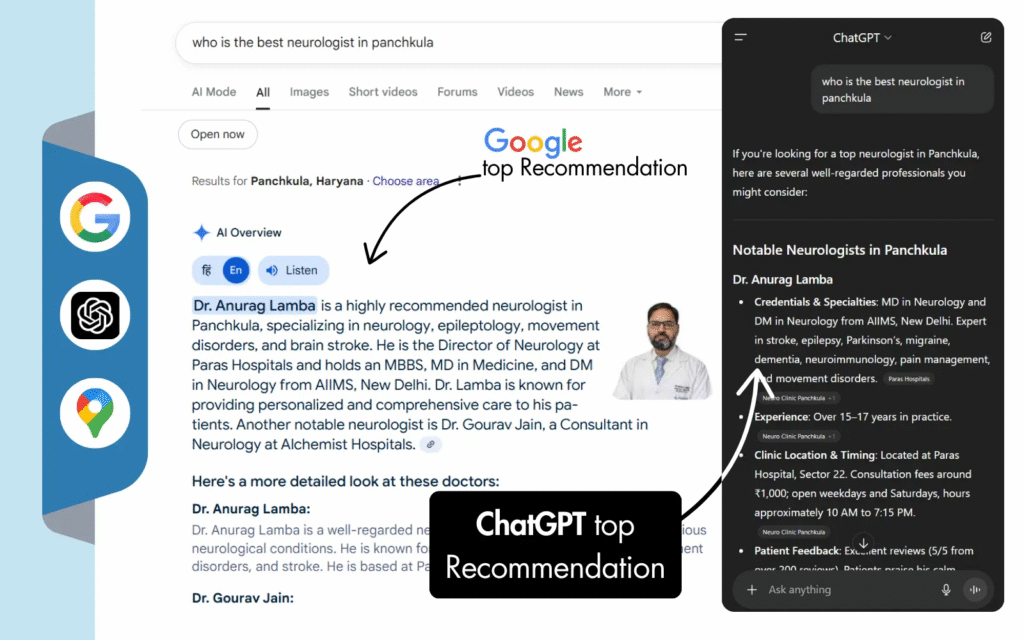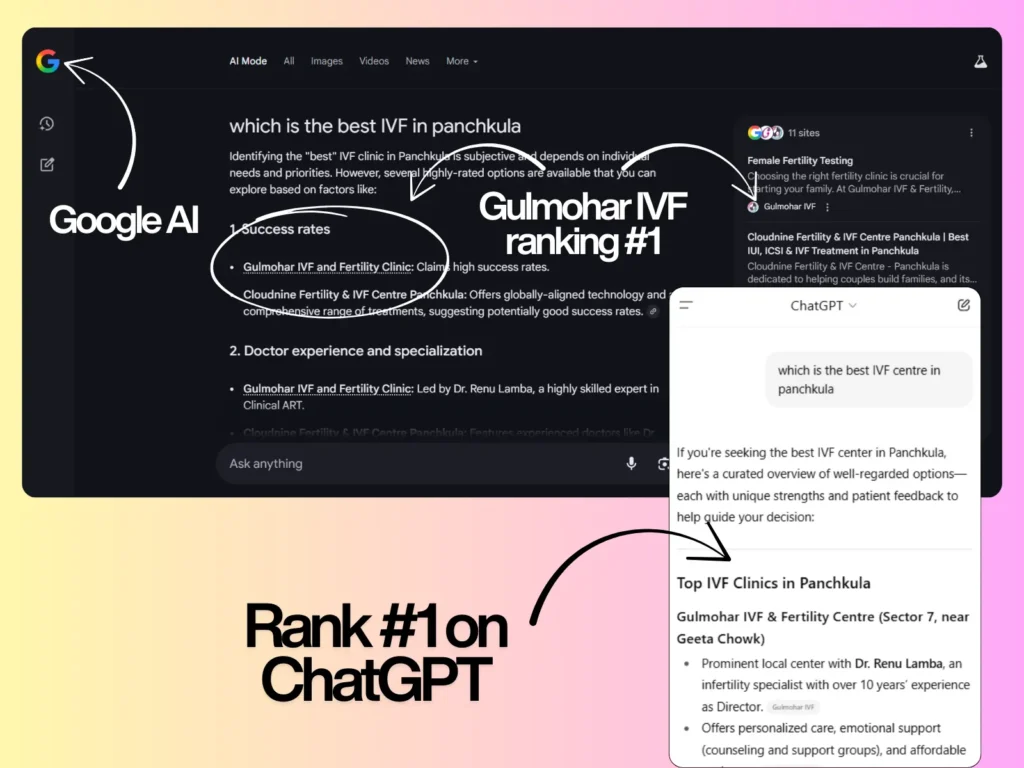Introduction: The New Reality of Search
Patients no longer begin their search for healthcare in waiting rooms or phone directories. They begin with Google, ChatGPT, Bing AI, and increasingly with Google’s AI Overview. When patients type “best doctor near me” they believe they will find the top expertise. In practice they find the doctor or clinic that has the strongest visibility across AI systems and local search. This shift means skill and credibility alone are no longer enough. Visibility has become the bridge between the best and the chosen.
This is where Large Language Model SEO, or LLM SEO, plays a role. It is not just another layer of search optimization. It is a system designed to make doctors and clinics discoverable inside AI-driven results that patients are already relying on. At RankVed, we have implemented this framework for real healthcare brands. In this article we present two detailed case studies with data and proof: Dr. Anurag Lamba, a neurologist in Panchkula, and Gulmohar IVF, a fertility clinic.
What is LLM SEO and Why It Matters
The Rise of AI Search Engines
Search behavior is changing rapidly. ChatGPT, Gemini, and Bing AI now provide direct answers instead of ten blue links. Google AI Overview summarises content and displays trusted sources before the standard SERP. Voice assistants such as Siri and Alexa pull results from AI-driven indices. In this environment, a clinic can have the best expertise yet remain invisible if AI systems are not trained to recognize and cite its content.
Core Components of LLM SEO
LLM SEO provides the structure and authority signals that help AI systems choose your clinic as a reliable source. The main components are:
- LLM.txt: A file that tells AI crawlers which pages to prioritize, similar to robots.txt but designed for LLMs.
- Schema markup: Structured data for doctors, treatments, and FAQs that communicates expertise directly to machines.
- E-E-A-T signals: Clear evidence of Experience, Expertise, Authoritativeness, and Trustworthiness on every page.
- Content clusters: Pillar pages supported by detailed blogs that cover related patient questions and can be cited in AI responses.
- Reputation signals: Reviews, backlinks, and citations that validate trust in real-world contexts.
Case Study 1: Dr. Anurag Lamba, Neurologist in Panchkula
The Challenge
Dr. Anurag is a highly qualified neurologist with MBBS, MD, and DM from AIIMS Delhi and serves as Director of Neurology at Paras Hospital. Despite this, he was not surfacing in AI search results. Patients searching for “best neurologist in Panchkula” often found less experienced names ranking higher. ChatGPT and Bing AI rarely mentioned his clinic, and Google’s AI Overview did not highlight him. The skill was present, but the visibility was missing.

The Strategy We Used
We designed a five-step LLM SEO plan:
- LLM.txt deployment: A custom file listed his bio, condition pages, treatment descriptions, and authority blogs as priority URLs for AI engines. This gave models like ChatGPT and Perplexity a clear map of what to cite.
- Schema optimization: Person schema with verified degrees, affiliations, and hospital role; MedicalCondition and MedicalProcedure schema on service pages covering stroke, epilepsy, and migraine; FAQ schema answering patient queries in structured form.
- Content clusters: Each major neurological condition was supported by multiple interlinked blogs. For example, the migraine cluster included causes, diagnosis, triggers, and treatment guidance.
- E-E-A-T enhancements: Author bios on every blog, editorial review notes, patient testimonials, and media features were added to demonstrate authority.
- Reputation building: Google Business Profile was improved with new reviews and Q&A. Backlinks were acquired from neurology associations, health blogs, and local news.
The Results
Within six months:
- Dr. Anurag became the top recommendation in Google AI Overview for neurology searches in Panchkula.
- He was listed in ChatGPT’s Notable Neurologists section, complete with credentials.
- Search Console showed 47.9K impressions, 963 clicks, 2% CTR, and an average position of 12.2.
The Impact
Patients now encounter Dr. Anurag before they even click. They see his profile inside AI summaries, which builds instant trust. By the time they reach his website, they already perceive credibility. This has led to measurable increases in patient inquiries and appointments.
Case Study 2: Gulmohar IVF, Panchkula
The Challenge
In IVF care, competition is intense. Corporate chains like Apollo and Cloudnine dominate advertising and search space. Gulmohar IVF had excellent patient outcomes but lacked visibility. It needed a strategy to compete against larger brands while maintaining local trust.

The Strategy We Used
We implemented a dual Local SEO and LLM SEO approach:
- LLM.txt setup: Highlighted IVF-specific landing pages such as IVF Cost, IVF Success Rate, IUI, and ICSI. This guided AI engines to pick the most relevant URLs.
- Local SEO enhancement: Consistency of Name, Address, and Phone across fifty directories. Google Business Profile upgraded with services, images, and FAQs.
- Schema markup: MedicalClinic schema on the homepage, Service schema on treatment pages, and FAQ schema for IVF costs and processes.
- Content clusters: Blogs addressing IVF myths, emotional aspects, success rates, and cost comparisons in Panchkula.
- Authority building: Backlinks from fertility forums, women’s health magazines, and local PR mentions.
The Results
Over six months:
- Gulmohar IVF entered the Top 3 Google Map Pack for “best IVF in Panchkula”.
- It was recommended by Microsoft Bing AI for fertility searches.
- Search Console showed 21.2K impressions, 385 clicks, 1.8% CTR, with average position improving from 27.1 upward.
The Impact
Patients now encounter Gulmohar IVF in both AI answers and Google Maps. This dual visibility places them side by side with corporate competitors but with the added advantage of personal care. Trust and inquiries have both grown steadily.
Key Lessons for Doctors and Clinics
- LLM.txt is now critical: Without it, AI engines decide what to use without guidance.
- Schema is mandatory: Person, Clinic, Condition, and FAQ schema make the difference between being trusted or ignored.
- Content must be AI-ready: Blogs and FAQs should be written in short, clear sections that can be quoted easily.
- Visibility drives trust: Patients see AI recommendations as unbiased, which accelerates decision-making.
- Local SEO and LLM SEO work best together: Maps bring footfall, AI results bring credibility.
Conclusion and Free Checklist
The experiences of Dr. Anurag and Gulmohar IVF prove a clear truth. Patients search for the best but choose the visible. LLM SEO transforms skill and service into visibility and trust. It ensures that doctors and clinics are not only excellent but also discoverable in the exact places where patients make decisions.
To help you apply this, we have created a practical LLM SEO Checklist for Doctors and Clinics. It includes schema must-haves, an LLM.txt template, and a 15-step AI optimization framework.
Enter your details. We’ll send your PDF guide shortly. No spam, unsubscribe anytime.





